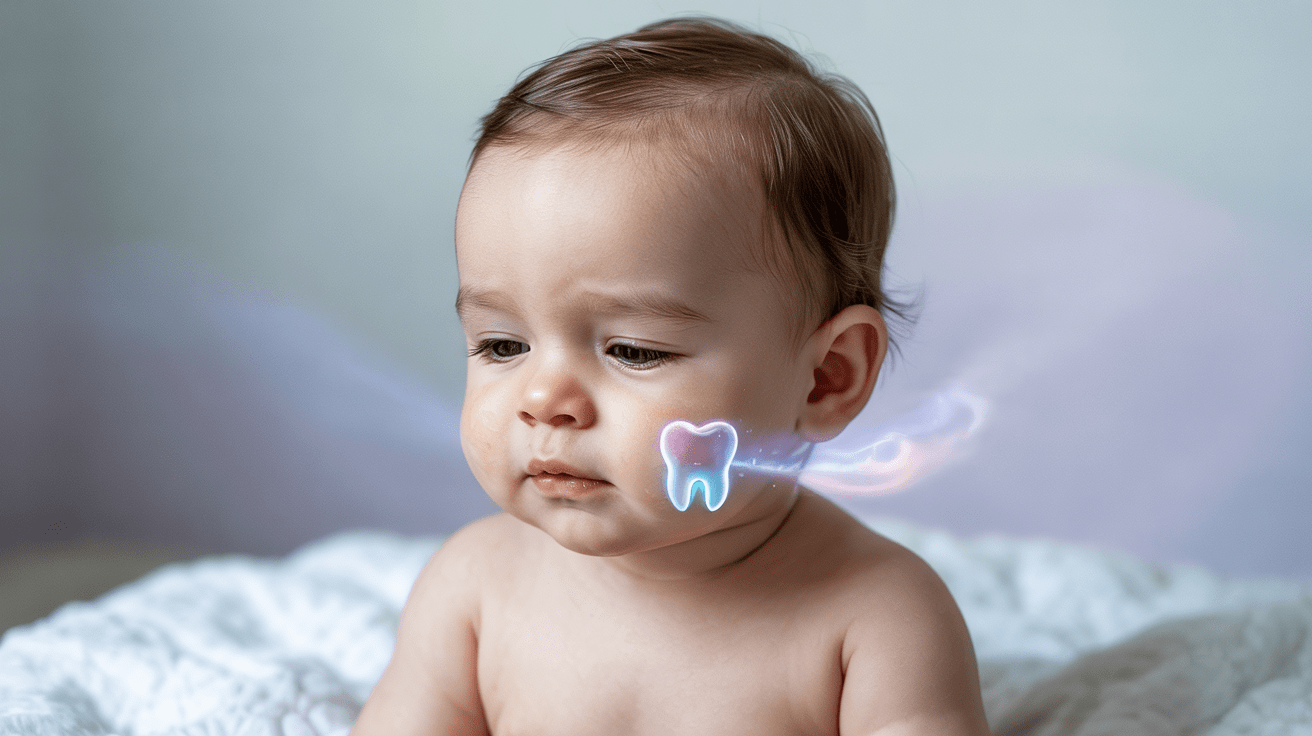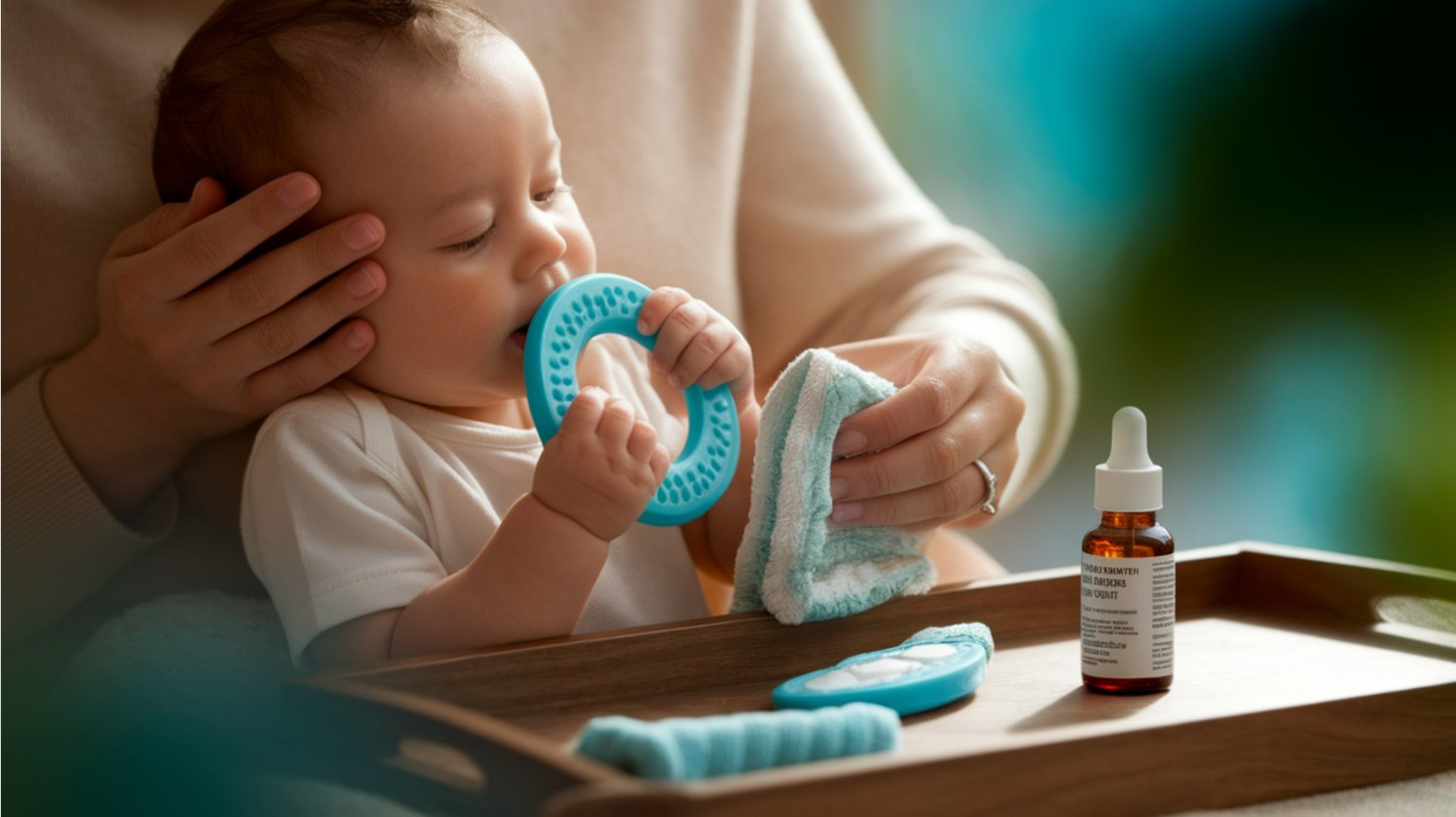
Those midnight cries from a teething baby can leave parents desperate for solutions. When your little one’s gums are inflamed and tender, nighttime discomfort often intensifies, disrupting sleep for everyone.
If you’re currently surviving on minimal sleep while comforting your teething baby, you’re not alone. Approximately 70% of babies experience significant sleep disturbances during teething periods.
The good news is that with some gentle, effective techniques, you can help ease your baby’s pain and get everyone more rest.
From safe pain relief options to simple comfort measures, these practical strategies are specifically tailored to ease nighttime teething troubles.
We understand you need solutions that work quickly when it’s 2 AM and your baby is uncomfortable. Let’s explore methods to soothe those sore gums and help your little one (and you) get back to sleep.
Understanding Teething and Nighttime Discomfort
Those tiny teeth pushing through tender gums can make nights tough for babies and parents. Most babies start teething around 6 months, and it can disrupt sleep patterns that were beginning to stabilize.
Watch for signs like increased drooling, chewing on everything, ear pulling, and night waking.
Your calm baby might suddenly become fussy, especially at bedtime.
Why is night worse? When babies lie down, blood flow increases to their head and gums, making the pressure and pain more intense. Plus, without daytime distractions, they notice the discomfort more.
The good news is that each tooth won’t cause problems forever. The worst discomfort usually lasts just a few days as teeth break through the gums.
Why Does Teething Disrupt Sleep?

Teething causes more than sore gums—it creates a perfect storm for sleep problems. When teeth push through sensitive gum tissue, your baby experiences pain that often worsens at night when there are fewer distractions.
The discomfort triggers increased drooling, which can lead to rashes and coughing. Many babies also develop mild fevers and diarrhea during teething, adding to their nighttime misery.
Your baby’s sleep cycle is disrupted because pain makes it harder to fall asleep and stay asleep. They may wake more frequently, seeking comfort from strange sensations in their mouth.
This timing is especially frustrating because many babies begin developing better sleep patterns around 4-6 months—right when teething often begins. The good news? Each tooth doesn’t disrupt sleep forever, and you can help manage these temporary challenges.
Pro Tip: Keep a teething diary for a week. Note when your baby seems most uncomfortable and what helps them. This can help you spot patterns and prepare for difficult nights.
Signs Your Baby is Teething at Night

Wondering if teething is behind those midnight wakings? Look for these telltale signs. Your baby might become unusually fussy right at bedtime or wake frequently throughout the night, crying or whimpering.
Check their sleepwear and sheets—excessive drooling during sleep is a major clue. You might notice them constantly pulling at their ears or rubbing their cheeks, which happens because pain can radiate from the gums to these areas.
Many teething babies suddenly change their feeding patterns at night, either nursing more frequently for comfort or refusing to eat because sucking hurts their gums.
Another common sign is their sudden hatred of lying flat—the horizontal position can increase pressure and pain in their mouth. Your baby might fight being put down or wake screaming shortly after being laid in their crib.
Immediate Comfort Techniques
Sleep regressions often coincide with teething discomfort, which can significantly disrupt your baby’s sleep patterns. The techniques outlined provide immediate relief through temperature-based methods like chilled teething rings and cool washcloths that help numb sore gums.
These cold therapy approaches work alongside gentle pressure techniques such as finger massage and specialized hold positions that redistribute pressure away from sensitive areas.
Cold Relief Methods: Teething Rings and Toys

Keep a few teething rings in the refrigerator (avoid the freezer as it can be too cold). The cool pressure helps numb sore gums while various textures gently massage painful areas. Always ensure the teethers are solid, with no small parts that could break off.
Chilled Washcloths
Wet a clean washcloth, twist it slightly, and chill it in the refrigerator. The cold, textured fabric provides soothing relief and massages sore gums. Its larger size reduces choking hazards compared to small teething toys.
Refrigerated Teething Toys
Some teething toys are designed to be chilled, either by containing water that remains cool longer or by offering varied textures. These toys provide different soothing options so your baby can find the one that feels best.
Gentle Soothing Strategies Massage Techniques

Gently rub your baby’s gums with a clean finger. The counter-pressure created by light massage can ease the discomfort of emerging teeth. Start with gentle pressure and adjust according to your baby’s reaction.
Comforting Hold Positions
Holding your baby upright against your shoulder or using positions like the “tiger in the tree” (baby lying on their tummy along your forearm with head near your elbow) can reduce pressure on the head and gums, providing comfort during teething episodes.
Gentle Gum Rubbing
Using a damp, chilled washcloth or a silicone fingertip toothbrush, apply gentle pressure on the gums. Experiment with different textures and pressures to determine what helps your baby feel most comfortable—always be gentle and respond to your baby’s cues.
Natural Pain Relief Approaches

Worried about your crying baby, no comfort measure is enough; you might need something more for pain relief. In such moments, safe medication—used with guidance—can make a big difference.
Safe Over-the-Counter Options
Safe over-the-counter medicine can offer relief when teething pain disrupts sleep. Always check with a pediatrician before giving any medication.
Recommended Pain Relievers
Acetaminophen (Tylenol) or ibuprofen (for babies over 6 months) can help reduce pain and inflammation. These medications are generally safe when used correctly and can help your baby sleep through particularly rough nights.
Dosage Guidelines
Always follow the dosage instructions on the package based on your baby’s weight, not age. Never give more than recommended, even if your baby seems very uncomfortable. If you’re unsure about dosing, call your pediatrician before giving any medication.
Pro Tip: Use medication sparingly, for the worst nights only. Keep a log of when you give medicine so you don’t accidentally give too much if parents are taking turns with night duty.
Homeopathic and Natural Remedies
Natural remedies can offer gentle support during teething. Always consult your pediatrician before trying any homeopathic options to ensure safety and effectiveness.
Teething Gels: Be careful with teething gels. The FDA warns against using products with benzocaine due to rare but serious side effects. If you choose to use a gel, look for natural options without benzocaine, lidocaine, or alcohol.
Natural Pain Relief Alternatives: Some parents find that natural remedies like chamomile tea (cooled) on a washcloth can be soothing. Amber necklaces are popular but have no scientific evidence supporting them and pose choking hazards. If you use them, never leave them on during sleep.
Safety Considerations: Always check with your pediatrician before using any natural remedy. What seems “natural” isn’t always safe for babies. Never use honey (risk of botulism) or essential oils (can be dangerous for babies) as teething remedies.
Creating a Soothing Nighttime Routine

A calm, consistent bedtime routine helps signal to your baby that it’s time to sleep, even when teething discomfort strikes.
Establishing a Calm Environment
Your baby’s sleep space can make a big difference in how well they sleeps through teething pain.
- Dimming Lights: About 30 minutes before bedtime, start dimming lights around the house. This helps trigger your baby’s natural sleep hormones. Use a very dim nightlight for nighttime check-ins so you don’t fully wake your baby.
- Soft Music or White Noise: A consistent sound can mask household noises and provide comfort. White noise, gentle lullabies, or even the sound of a fan can help your teething baby stay asleep once they drift off.
- Comfortable Sleep Setting: Make sure your baby’s sleeping space is comfortable – not too hot or cold (68-72°F is ideal). A firm mattress with a fitted sheet (no loose bedding) provides a safe, comfortable sleep surface.
Bedtime Comfort Techniques

How you put your baby to bed can impact how well they sleeps through teething discomfort.
1. Gentle Nighttime Feeding
A full tummy helps many babies sleep better. To help them sleep longer stretches, consider a dream feed (feeding while they’re still mostly asleep) before you go to bed.
For breastfed babies, breast milk contains natural pain relievers that might help with teething pain.
2. Comforting Bedtime Rituals
Consistency is key. A predictable routine, such as a bath, story, feeding, and then bed, helps your baby know what to expect. During teething, you might add gentle gum massage or offer a cold teether before the final step of putting them down.
3. Managing Nighttime Wakings
When your teething baby wakes crying, try the least disruptive solution first. Offer a teether or pacifier before picking them up. If you do need to hold them, keep the lights low and interaction minimal to signal it’s still sleep time.
Pro Tip: Take turns with your partner for nighttime comfort duty if possible. A well-rested parent can better handle a fussy teething baby, and your baby benefits from having parents who aren’t exhausted.
Long-Term Teething Management

Managing teething requires ongoing strategies as multiple teeth emerge over months. Understanding developmental patterns, maintaining proper oral hygiene, and adapting comfort techniques for each stage ensures smoother teething experiences.
1. Tracking Tooth Development
Your baby’s teeth typically follow a predictable emergence pattern, starting with lower central incisors around 6 months, followed by upper central incisors.
Lateral incisors, first molars, canines, and second molars complete the set by age three.
This progression isn’t exact—some babies develop teeth earlier or later, while others experience multiple teeth emerging simultaneously. Keeping a simple tooth eruption chart helps anticipate challenging periods and prepare accordingly.
Understanding that each tooth’s arrival might trigger discomfort, excessive drooling, and temporary sleep disruptions allows you to implement targeted relief strategies before symptoms intensify.
2. Oral Hygiene Tips
Establishing proper oral care routines begins before teeth emerge. Gently wipe your baby’s gums with a clean, damp washcloth after feedings to remove bacteria and accustom them to mouth cleaning.
Once teeth appear, transition to an infant-sized toothbrush with soft bristles and apply a rice-grain-sized amount of fluoride toothpaste twice daily. Clean thoroughly along the gum line, where bacteria accumulates.
Consider making brushing playful through songs, colorful toothbrushes, or mirroring your brushing.
3. Supporting Your Baby Through Different Teething Stages
Each tooth type presents unique challenges, requiring adaptive relief strategies. Front incisors typically cause moderate discomfort but emerge relatively quickly.
Canines, with their pointed shape, often create sharper pain during eruption. Molars with substantially larger surfaces frequently trigger the most pronounced discomfort, sometimes lasting weeks.
Customize your approach accordingly—cold teethers work well for front teeth, while gentle gum massage may better soothe emerging molars.
When to Seek Medical Advice
While teething is normal, sometimes there are signs that something else might be wrong.
Red Flags During Teething
Normal teething shouldn’t cause high fevers, severe diarrhea, or extreme fussiness that medicine doesn’t help. If your baby seems unusually sick rather than just uncomfortable, it’s time to call the doctor.
Signs of Infection
Watch for signs that might indicate an ear infection or other problem: tugging ears along with high fever, refusing to eat or drink for extended periods, or extreme irritability that doesn’t improve with pain relief measures.
Consulting Your Pediatrician
Don’t hesitate to call your doctor if you’re worried. It’s better to check and find out it’s just teething than to miss something that needs treatment. Your pediatrician can also recommend specific remedies for your baby’s situation.
The Last Note
Teething is a temporary challenge that every baby faces differently. From cold teethers and gentle massage to properly timed pain relievers and consistent bedtime routines, you now have a complete toolkit to soothe your baby’s nighttime teething discomfort.
Remember that most teething pain peaks for just a few days as each tooth emerges. Track your baby’s tooth development to anticipate difficult nights, maintain good oral hygiene from the start, and don’t hesitate to consult your pediatrician when in doubt.
With patience and these proven techniques, you’ll help your little one guide this important milestone while preserving precious sleep for the whole family.
If you’re interested in more informational content on mothers and babies, feel free to click here and examine other blogs that you might enjoy.
